What is the storage engine in Mysql database
Storage Engine
What is a storage engine?
Like the engines in airplanes and rockets, the storage engine is a very critical component of the database. Obviously not, because the use of storage engines must be based on specific scenarios. In Mysql, the storage engine is the same, and it is not good or bad. We need to choose the appropriate storage engine to adapt to different scenarios in order to do our best. The storage engine is the implementation of technologies such as storing data, creating indexes, and updating/querying data. Table types can be called storage engines because storage engines are based on tables rather than libraries.
The architecture of Mysql:
The architecture of Mysql is divided into four layers:
The architecture of MYsql is shown in the figure below:

Connection layer
The top layer is some clients and link services, which mainly complete some connection processing, authorization authentication, and related security solutions. The server will also provide secure access for each A client verifies the operating permissions it has.
Service layer
The second layer architecture mainly completes most of the core service functions, such as SOL interface, and completes cache query, SOL analysis and optimization, and the execution of some built-in functions. All cross-storage engine functions are also implemented in this layer, such as procedures, functions, etc.
Engine layer
The storage engine is the key component responsible for data storage and retrieval in MvSOL. The server communicates with the storage engine using APIs. Choose the appropriate storage engine according to your needs, because different storage engines have different functions.
Storage layer
Mainly stores data on the file system and completes the interaction with the storage engine.
View of storage engines
Starting from MySQL 5.5, the InnoDB storage engine becomes the default storage engine, and of course there are many other storage engines to choose from. Previously, the default was the Memory storage engine.
show engines;
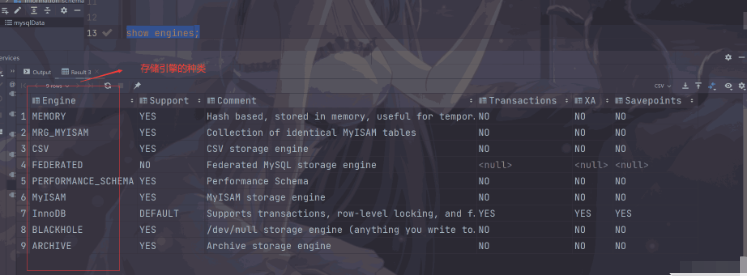
create table Course(
Con int primary key auto_increment,
Cname varchar(10),
Cpon int,
Ccredit int
)
show create table course;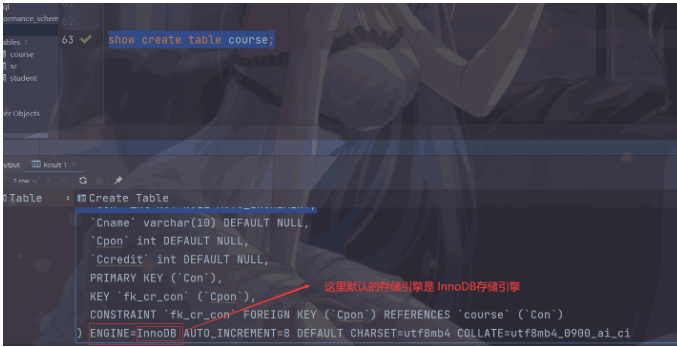
Specification of storage engine
For example, we can specify when creating a table The storage engine type for this table.
create table test_mysql(
name varchar(10),
age int
) engine = Memory;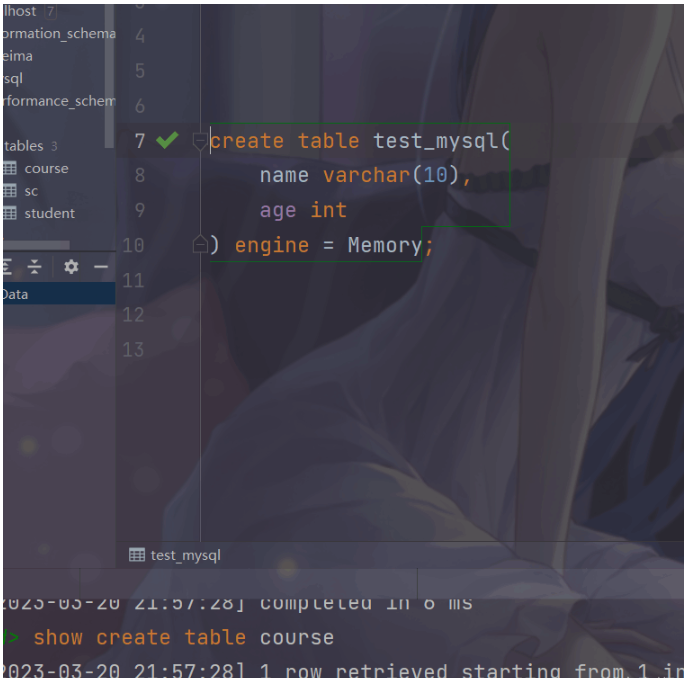
Features of storage engine
Here we focus on the following InnoDB
InnoDB introduction
InnoDB is a general-purpose storage engine that combines high reliability and high performance. After MvSOL 5.5, InnoDB is the default MvSOL storage engine.
InnoDB features
DML operations follow the ACID model and support transactions;
Row-level locks to improve concurrent access performance;
Support foreign key FOREIGN KEY constraints to ensure the integrity and correctness of data:
InnoDB file
xxx.ibd:xxx represents the table name. Each table in the innoDB engine will correspond to such a table Spatial file, which stores the table structure (frm, sdi), data and indexes of the table.
Parameters: innodb file per table

# #Finally, use a picture to show the logical storage structure of InnoDB.
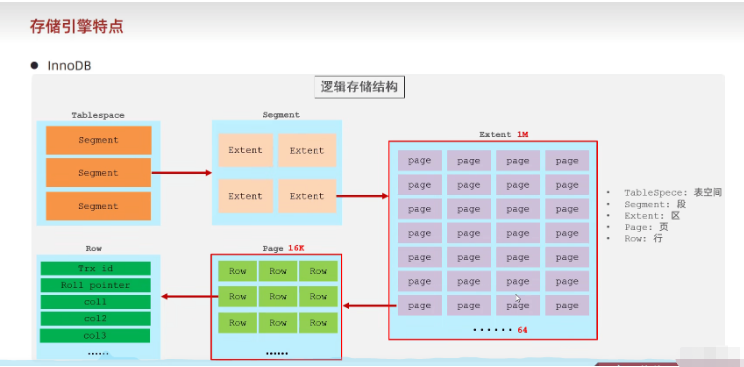
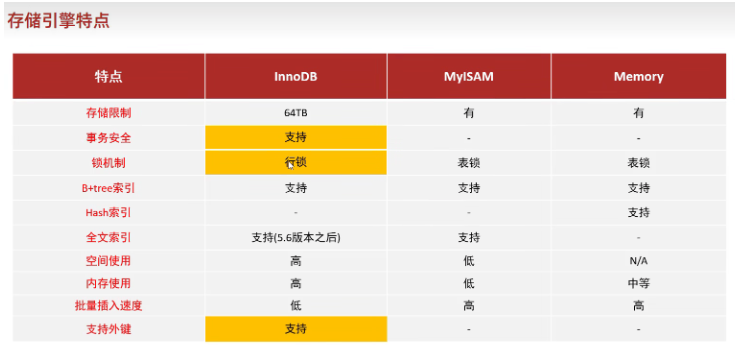
Summary: InnoDB supports transactions, but MyISAM does not; InnoDB supports row locks. MyISAM does not support it and supports table locks; InnoDB supports foreign keys, but MyISAM does not support it;
Selection of storage engine
The above is the detailed content of What is the storage engine in Mysql database. For more information, please follow other related articles on the PHP Chinese website!

Hot AI Tools

Undresser.AI Undress
AI-powered app for creating realistic nude photos

AI Clothes Remover
Online AI tool for removing clothes from photos.

Undress AI Tool
Undress images for free

Clothoff.io
AI clothes remover

Video Face Swap
Swap faces in any video effortlessly with our completely free AI face swap tool!

Hot Article

Hot Tools

Notepad++7.3.1
Easy-to-use and free code editor

SublimeText3 Chinese version
Chinese version, very easy to use

Zend Studio 13.0.1
Powerful PHP integrated development environment

Dreamweaver CS6
Visual web development tools

SublimeText3 Mac version
God-level code editing software (SublimeText3)

Hot Topics
 MySQL's Role: Databases in Web Applications
Apr 17, 2025 am 12:23 AM
MySQL's Role: Databases in Web Applications
Apr 17, 2025 am 12:23 AM
The main role of MySQL in web applications is to store and manage data. 1.MySQL efficiently processes user information, product catalogs, transaction records and other data. 2. Through SQL query, developers can extract information from the database to generate dynamic content. 3.MySQL works based on the client-server model to ensure acceptable query speed.
 How to start mysql by docker
Apr 15, 2025 pm 12:09 PM
How to start mysql by docker
Apr 15, 2025 pm 12:09 PM
The process of starting MySQL in Docker consists of the following steps: Pull the MySQL image to create and start the container, set the root user password, and map the port verification connection Create the database and the user grants all permissions to the database
 Laravel Introduction Example
Apr 18, 2025 pm 12:45 PM
Laravel Introduction Example
Apr 18, 2025 pm 12:45 PM
Laravel is a PHP framework for easy building of web applications. It provides a range of powerful features including: Installation: Install the Laravel CLI globally with Composer and create applications in the project directory. Routing: Define the relationship between the URL and the handler in routes/web.php. View: Create a view in resources/views to render the application's interface. Database Integration: Provides out-of-the-box integration with databases such as MySQL and uses migration to create and modify tables. Model and Controller: The model represents the database entity and the controller processes HTTP requests.
 Solve database connection problem: a practical case of using minii/db library
Apr 18, 2025 am 07:09 AM
Solve database connection problem: a practical case of using minii/db library
Apr 18, 2025 am 07:09 AM
I encountered a tricky problem when developing a small application: the need to quickly integrate a lightweight database operation library. After trying multiple libraries, I found that they either have too much functionality or are not very compatible. Eventually, I found minii/db, a simplified version based on Yii2 that solved my problem perfectly.
 How to install mysql in centos7
Apr 14, 2025 pm 08:30 PM
How to install mysql in centos7
Apr 14, 2025 pm 08:30 PM
The key to installing MySQL elegantly is to add the official MySQL repository. The specific steps are as follows: Download the MySQL official GPG key to prevent phishing attacks. Add MySQL repository file: rpm -Uvh https://dev.mysql.com/get/mysql80-community-release-el7-3.noarch.rpm Update yum repository cache: yum update installation MySQL: yum install mysql-server startup MySQL service: systemctl start mysqld set up booting
 Centos install mysql
Apr 14, 2025 pm 08:09 PM
Centos install mysql
Apr 14, 2025 pm 08:09 PM
Installing MySQL on CentOS involves the following steps: Adding the appropriate MySQL yum source. Execute the yum install mysql-server command to install the MySQL server. Use the mysql_secure_installation command to make security settings, such as setting the root user password. Customize the MySQL configuration file as needed. Tune MySQL parameters and optimize databases for performance.
 Laravel framework installation method
Apr 18, 2025 pm 12:54 PM
Laravel framework installation method
Apr 18, 2025 pm 12:54 PM
Article summary: This article provides detailed step-by-step instructions to guide readers on how to easily install the Laravel framework. Laravel is a powerful PHP framework that speeds up the development process of web applications. This tutorial covers the installation process from system requirements to configuring databases and setting up routing. By following these steps, readers can quickly and efficiently lay a solid foundation for their Laravel project.
 MySQL vs. Other Programming Languages: A Comparison
Apr 19, 2025 am 12:22 AM
MySQL vs. Other Programming Languages: A Comparison
Apr 19, 2025 am 12:22 AM
Compared with other programming languages, MySQL is mainly used to store and manage data, while other languages such as Python, Java, and C are used for logical processing and application development. MySQL is known for its high performance, scalability and cross-platform support, suitable for data management needs, while other languages have advantages in their respective fields such as data analytics, enterprise applications, and system programming.






